When I was studying photography in college, my professor said there were three things that were imperative in making a successful image: technical ability, access to the subject and light. That last point has always stuck with me, and I’ve realized that light is just as important when designing and creating an engaging outdoor space as it is when photographing a subject. Don’t let light be an afterthought when designing your landscape. Make it a centerpiece and a point of conversation. Here are six good elements to work with.

jonathan alderson landscape architects, inc.
1. Architectural plants. Choose a plant with an interesting growth habit, such as this staghorn sumac (
Rhus typhina,
USDA zones 4 to 8; find your zone). Plant it near a wall or fence or on the side of your house (but not too close), so it will cast dramatic shadows on the surface behind it when the sun hits.
Other plants with an architectural quality to consider: agave (
Agave spp), yucca (
Yucca spp), crape myrtle (
Lagerstromia indica,
zones 7 to 9) and New Zealand flax (
Phormium spp, zones 8 to 11).

Dick Clark + Associates
2. Water. A flat surface of water not only creates a reflective plane for nearby trees and plants; it also has the ability to make a space feel larger than it is, even if the water surface isn’t very big. When building a pool or water feature, take into consideration trees and plants already on the site that can be reflected on the water’s surface.

Jocelyn H. Chilvers
You don’t have to have a large pool to take advantage of this technique. A simple pond or water feature with nearby plants would accomplish the same effect.
See how to make your own tranquil garden fountain

Banyon Tree Design Studio
3. Wood slats. By leaving space between boards on a fence, you can have screening and privacy while still allowing some light to filter through. Mix things up by using boards of varying widths to create a more interesting fence pattern, and the resulting shadows will create another layer of geometric interest.
See more wood slats in design

Jeffrey Gordon Smith Landscape Architecture
4. Opaque panels. Use tempered glass panels for an opaque surface that allows light to pass through while providing privacy.

MTLA- Mark Tessier Landscape Architecture
Place a plant behind a glass panel for an interesting ghostly effect. The form of this bird of paradise (
Strelitzia reginae) is partially silhouetted, but its details behind the panel are obscured.
Tip: Materials like transluscent polycarbonate can be a cost-effective alterntative to glass. Koda XT panels by 3form come in dozens of colors.
Learn more about using polycarbonates in design

b+g design inc.
5. Overhead structures. Many materials used for overhead structures can shield a space from natural light while still casting an interesting shadow. Here, wide wood slats provide filtered shade for the seating space below.

Wide slats overhead provide minimal shade but cast intriguing shadows in this outdoor dining space.

Djuna Design Studio
Design tip: Consider materials other than wood for slats. Depending on the style of your home, something like bamboo or steel may be more appropriate.

Exterior Worlds Landscaping & Design

Wolveridge Architects
6. Metal panels and railings. Laser-cut panels fixed to an overhead structure or used as a fence provide shade while casting creative shadows. Here, metal panels cast a geometric-patterned shadow on the outdoor cooking space from all sides.





